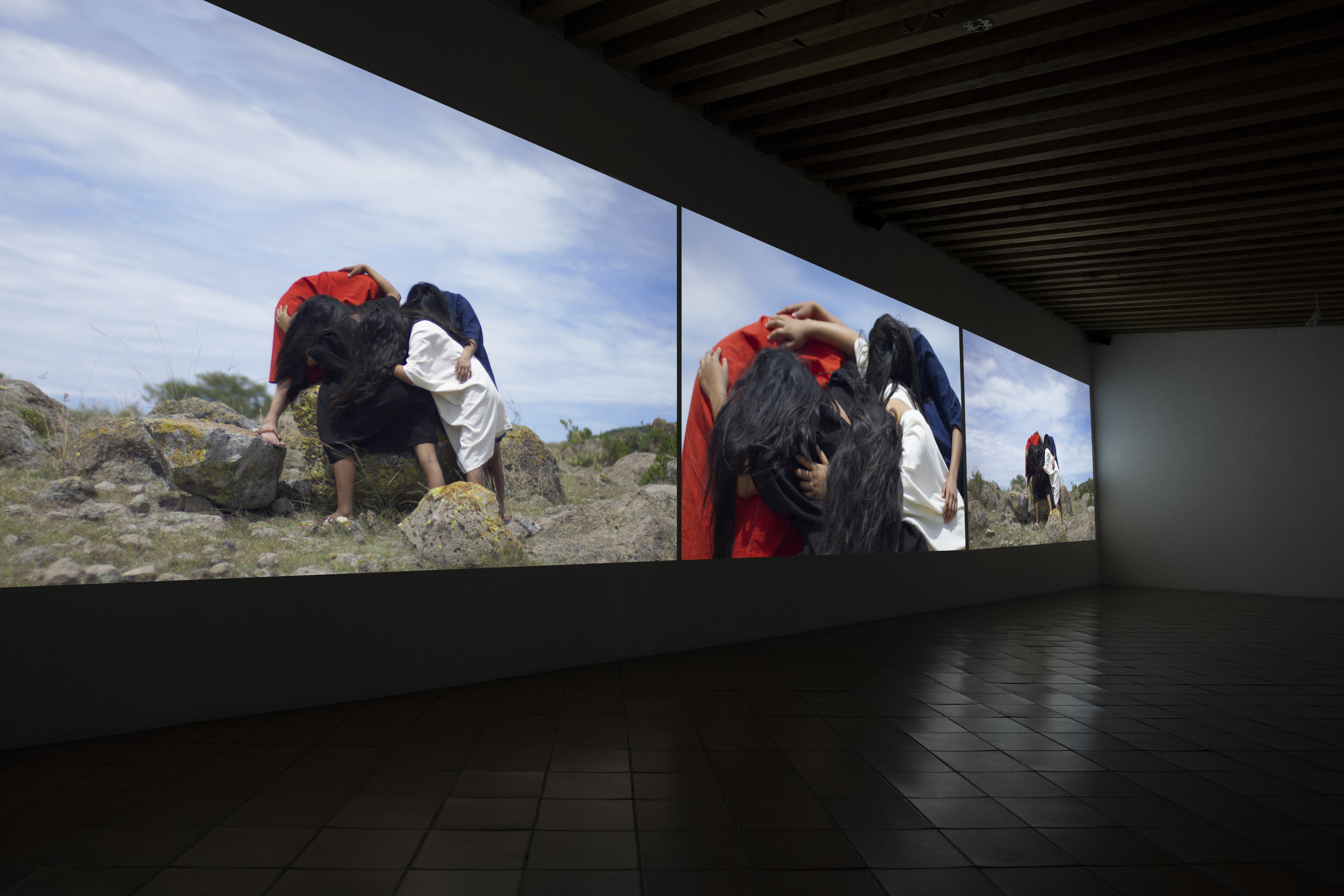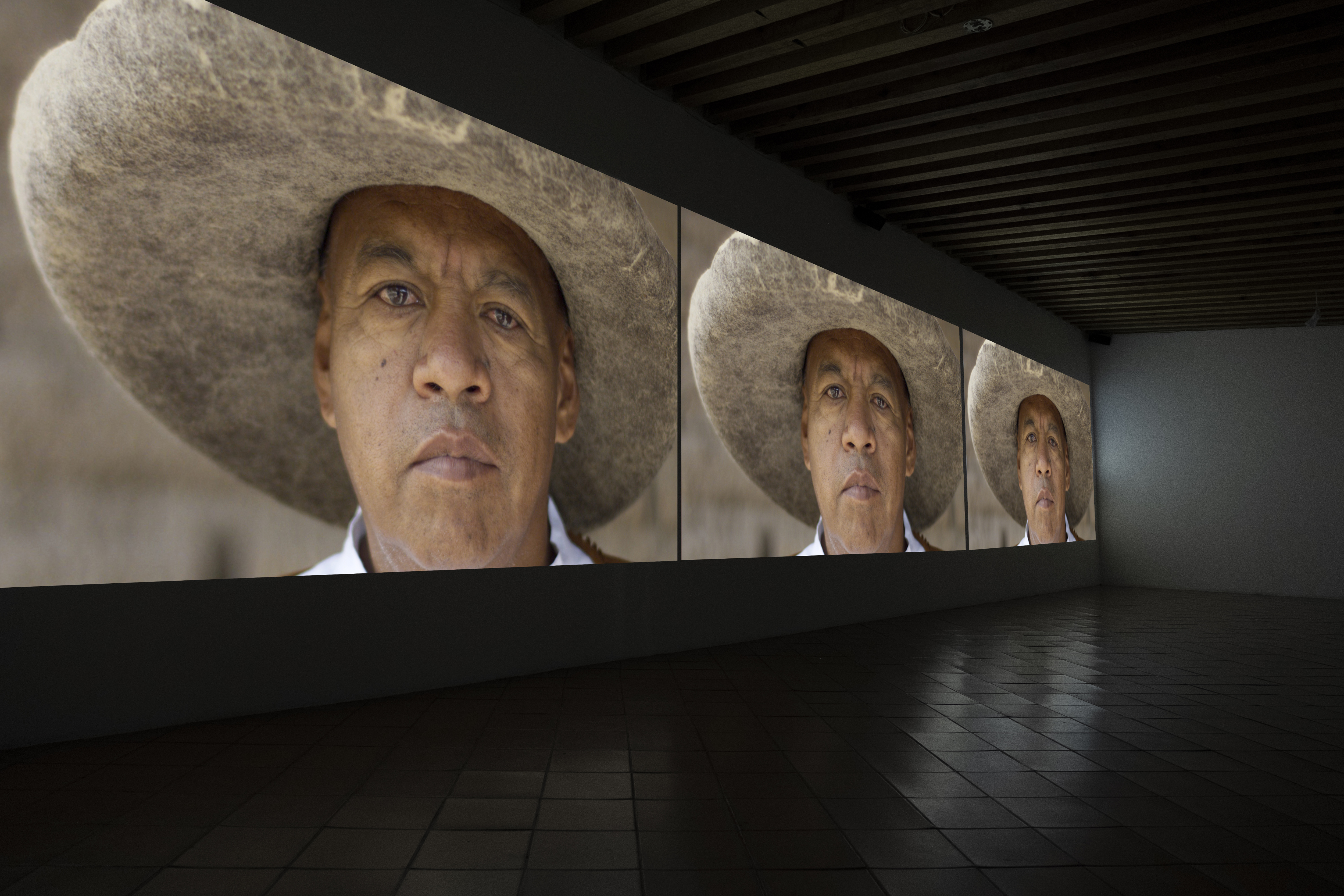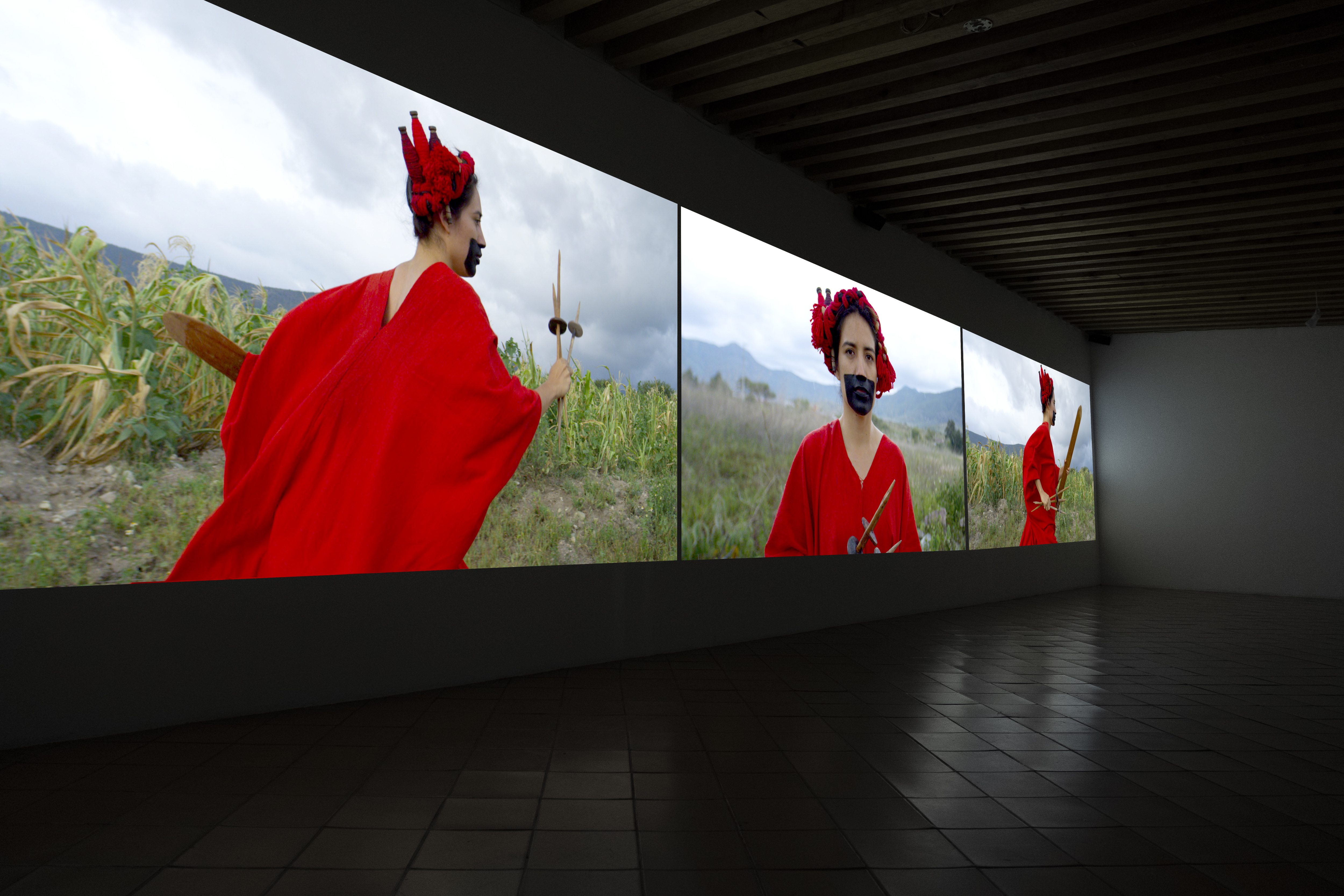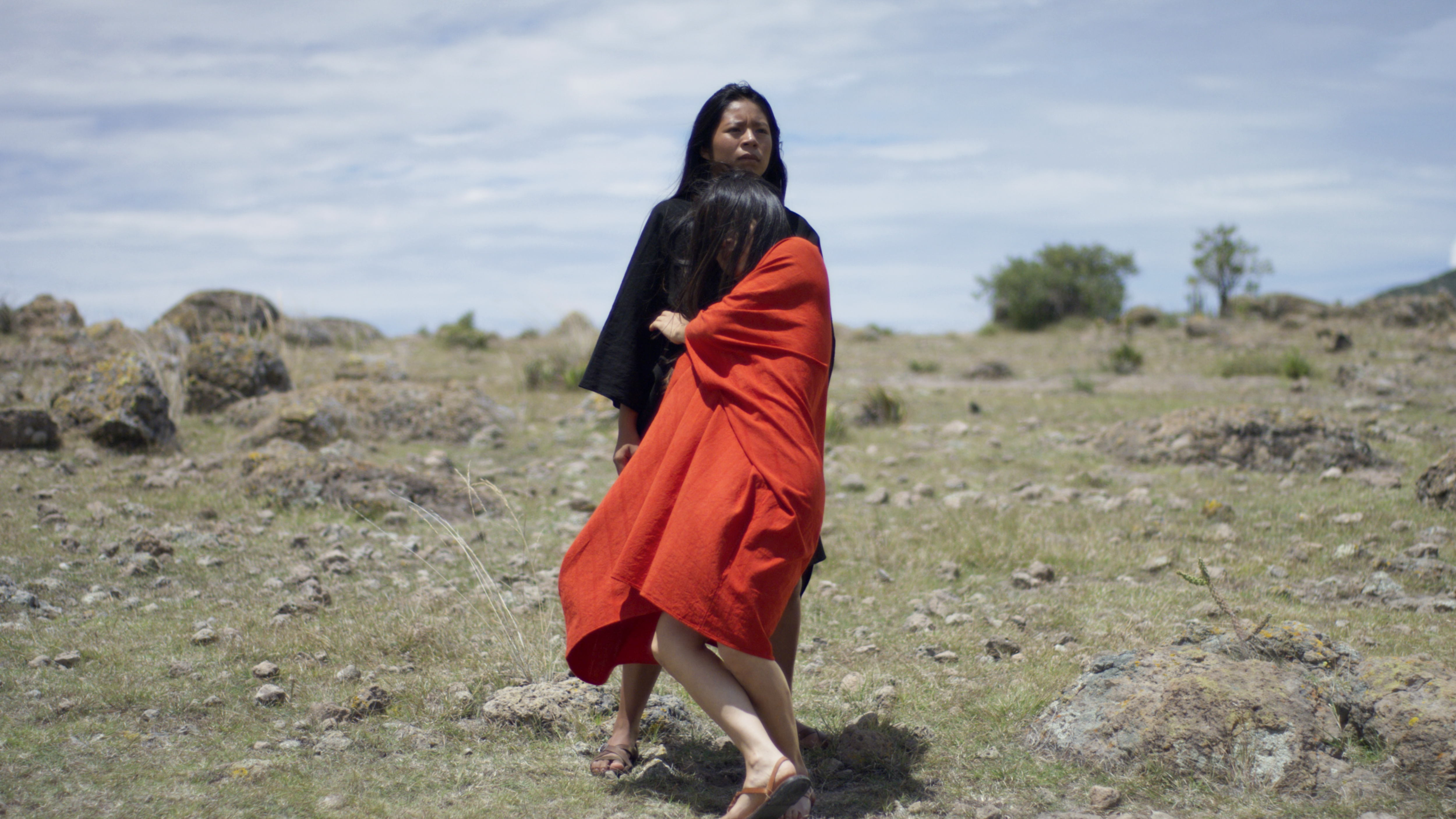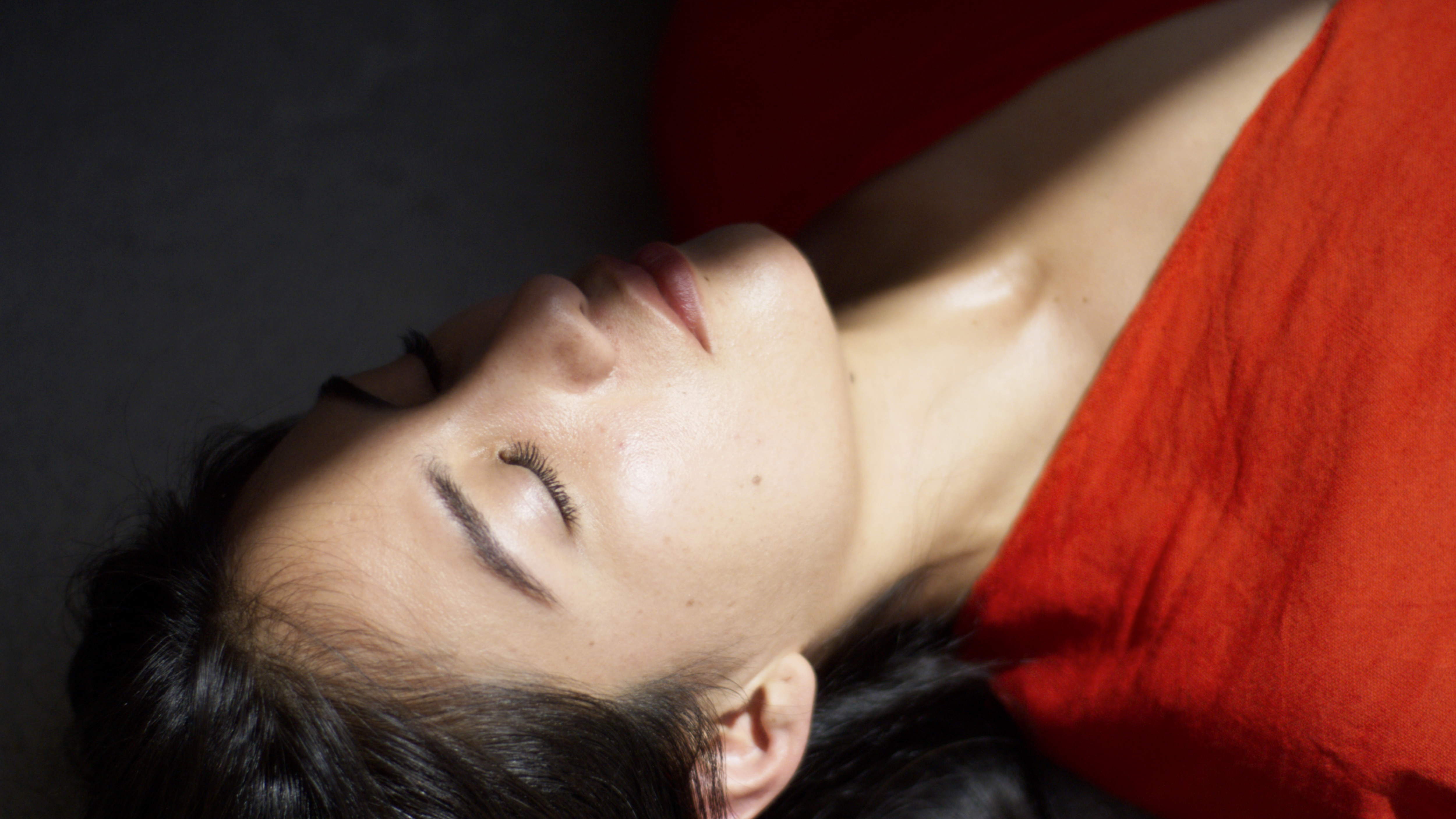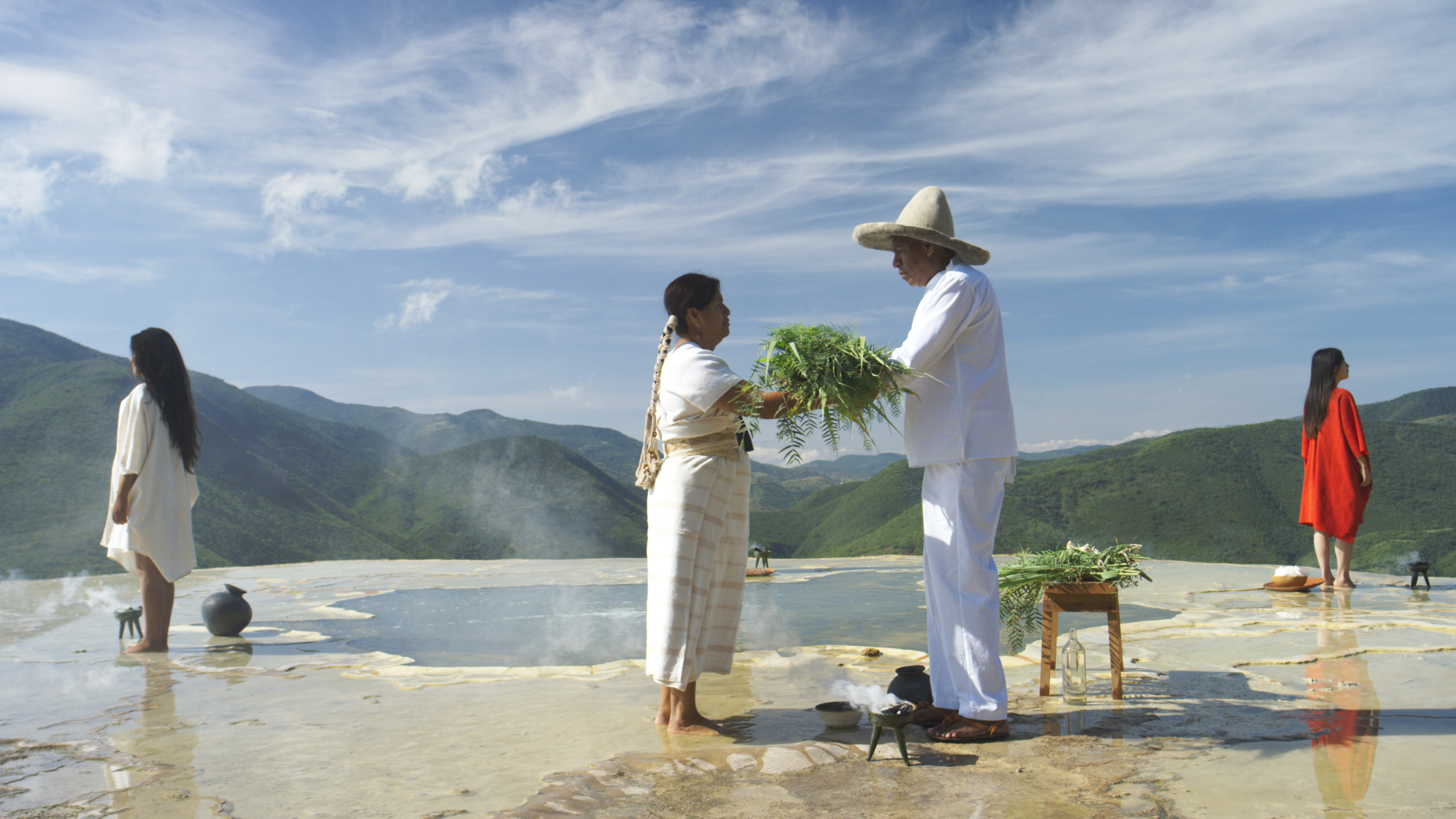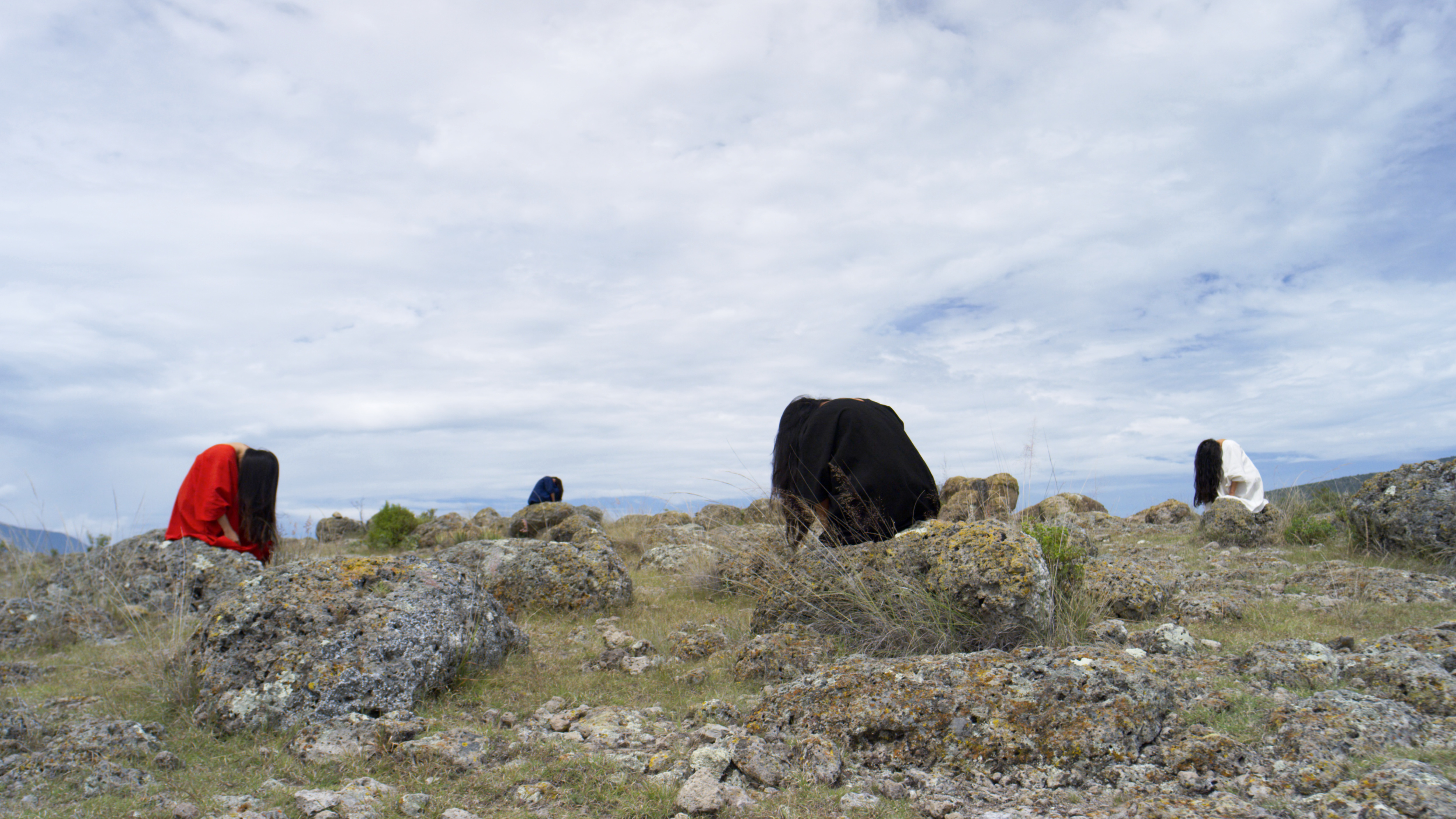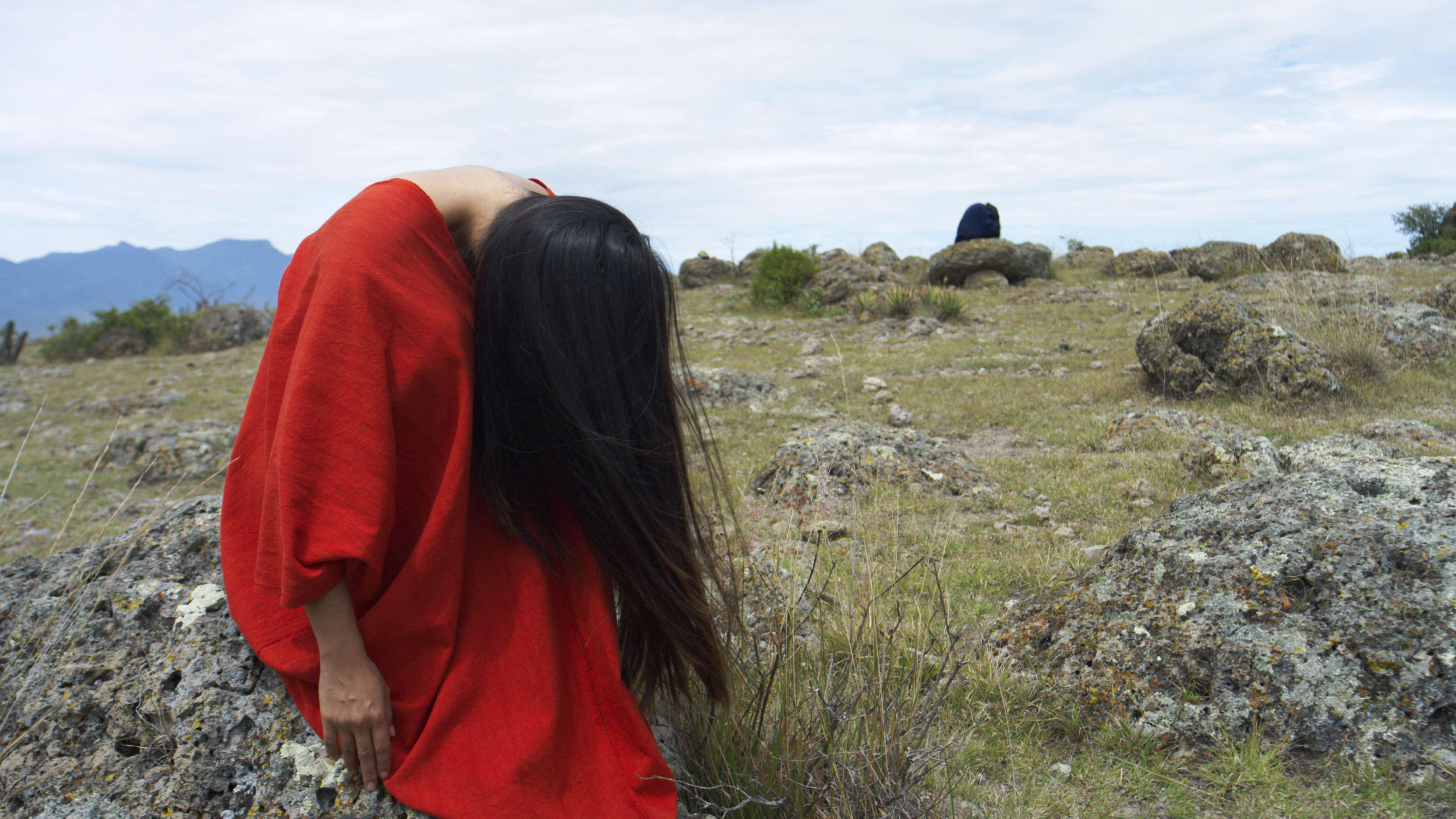ASCENT OF WEAVERS

Ascenso de Tejedoras, 2018
3-channel video installation, color, sound. 31:19 minutes, loop. Dimmensions variable. At MACO: 8 x 50 feet.
By Rebeca Méndez, with the Hernández Quero Family
Ascent of Weavers was commissioned by the Museum of Contemporary Art in Oaxaca, Mexico. The curators’ premise was to create a new work of art in collaboration with a local family of artisans. My collaborators are the Hernández Quero family, weavers of Zapotec descent from Mitla, home to the most important prehispanic religious center of the Zapotec culture, revered as the city of the dead. The name Mitla is derived from the Nahuatl name Mictlán, the underworld of Aztec mythology. I researched the history and culture of the Zapotec, of Mitla and weaving, and got to know the family through spending several weeks of conversation, meals together and healing ceremonies performed by one family member, Gildardo, who is also the keeper of knowledge of the family and of Mitla. Mitla has long relied on Gildardo’s oral tradition to preserve a record of its past.
I proposed to the family and the museum a film project focused on an indigenous cultural story of transformation and for the healing of the earth. Gildardo adapted his individual healing ceremony to a healing ceremony for the earth. Back home in Los Angeles I came across a research paper called “Women Weavers, Warrior Goddesses: Textile Tradition in the Zapotec Region of Southern Oaxaca” by the Mexican ethnographer Professor Damian Gonzalez Perez. In Zapotec mythology there are various accounts of women weavers represented as warrior goddesses. In the Codex Borgia or Codex Yoalli Ehēcatl, a Mesoamerican ritual and divinatory manuscript, there is a depiction of the weaving goddess Tlazolteotl, which became the base for my representation of the warrior goddess. My other characters were based on the directions of human life in prehispanic Zapotec civilization. They personified the cycles of the sun, the heavens, and the underworld.
The traditional garment worn by indigenous women in Mezoamerica is called a huipil. Throughout my video, I draw visual parallels between the geometry of the huipil and the architecture of the prehispanic archeological site of Mitla, where we filmed various scenes for the video. Mitla’s architectural designs were most likely inspired by textile patterns and may represent specific family lineages or geographical places. I designed the actants’ huipiles to represent the directions of human life in prehispanic Zapotec civilization—white for the rising sun, red for the setting sun, blue for the heavens, and black for the underworld. Although the Hernández Quero family also use the ‘Telar de Cintura’ (backstrap loom) technique learned from their ancestors, these huipiles were woven utilizing a ‘Telar de Pedal’ (pedal loom), an artisanal weaving method that uses the artisan’s feet to alternately lift and lower the thread.
Artist’s description:
For a world facing social and environmental crises, Ascent of Weavers is a call for awakening and action for collective healing of the earth. Entities of white, red, blue, and black embody cycles of the sun, the heavens, and the underworld and directions of human life in prehispanic Zapotec civilization. The entities undertake a journey into Mictlan (Lyobaa in Zapotec)—the underworld of the Mixtec mythology—aided by Xolotl (a canine god), who leads them through the underworld’s nine levels. Here they are challenged by piercing winds and crushing mountains, finally crossing rivers of blood to emerge as goddesses of weaving (Tlazolteotl, or Nohuichana in Zapotec)—warriors leading us to a more just, equitable, and sustainable relationship with our planet.
3-channel video installation, color, sound. 31:19 minutes, loop. Dimmensions variable. At MACO: 8 x 50 feet.
By Rebeca Méndez, with the Hernández Quero Family
Ascent of Weavers was commissioned by the Museum of Contemporary Art in Oaxaca, Mexico. The curators’ premise was to create a new work of art in collaboration with a local family of artisans. My collaborators are the Hernández Quero family, weavers of Zapotec descent from Mitla, home to the most important prehispanic religious center of the Zapotec culture, revered as the city of the dead. The name Mitla is derived from the Nahuatl name Mictlán, the underworld of Aztec mythology. I researched the history and culture of the Zapotec, of Mitla and weaving, and got to know the family through spending several weeks of conversation, meals together and healing ceremonies performed by one family member, Gildardo, who is also the keeper of knowledge of the family and of Mitla. Mitla has long relied on Gildardo’s oral tradition to preserve a record of its past.
I proposed to the family and the museum a film project focused on an indigenous cultural story of transformation and for the healing of the earth. Gildardo adapted his individual healing ceremony to a healing ceremony for the earth. Back home in Los Angeles I came across a research paper called “Women Weavers, Warrior Goddesses: Textile Tradition in the Zapotec Region of Southern Oaxaca” by the Mexican ethnographer Professor Damian Gonzalez Perez. In Zapotec mythology there are various accounts of women weavers represented as warrior goddesses. In the Codex Borgia or Codex Yoalli Ehēcatl, a Mesoamerican ritual and divinatory manuscript, there is a depiction of the weaving goddess Tlazolteotl, which became the base for my representation of the warrior goddess. My other characters were based on the directions of human life in prehispanic Zapotec civilization. They personified the cycles of the sun, the heavens, and the underworld.
The traditional garment worn by indigenous women in Mezoamerica is called a huipil. Throughout my video, I draw visual parallels between the geometry of the huipil and the architecture of the prehispanic archeological site of Mitla, where we filmed various scenes for the video. Mitla’s architectural designs were most likely inspired by textile patterns and may represent specific family lineages or geographical places. I designed the actants’ huipiles to represent the directions of human life in prehispanic Zapotec civilization—white for the rising sun, red for the setting sun, blue for the heavens, and black for the underworld. Although the Hernández Quero family also use the ‘Telar de Cintura’ (backstrap loom) technique learned from their ancestors, these huipiles were woven utilizing a ‘Telar de Pedal’ (pedal loom), an artisanal weaving method that uses the artisan’s feet to alternately lift and lower the thread.
Artist’s description:
For a world facing social and environmental crises, Ascent of Weavers is a call for awakening and action for collective healing of the earth. Entities of white, red, blue, and black embody cycles of the sun, the heavens, and the underworld and directions of human life in prehispanic Zapotec civilization. The entities undertake a journey into Mictlan (Lyobaa in Zapotec)—the underworld of the Mixtec mythology—aided by Xolotl (a canine god), who leads them through the underworld’s nine levels. Here they are challenged by piercing winds and crushing mountains, finally crossing rivers of blood to emerge as goddesses of weaving (Tlazolteotl, or Nohuichana in Zapotec)—warriors leading us to a more just, equitable, and sustainable relationship with our planet.
Exhibition History:
BAJO LA BÓVEDA AZUL COBALTO at MACO, Museo de Arte Contemporáneo de Oaxaca. Curated by Marietta Bernstorff. November 30, 2018 – May 17, 2019.
2019 LOS ANGELES LATINO INTERNATIONAL FILM FESTIVAL, art program. U.S. premiere at the Chinese Theaters in Hollywood, August 4, 2019.
Comment from the museum’s guest book:
Rebeca Méndez:
Todos los días recientes han sido un tormento y hoy, al ver la proyección volví a sentir el aire en mis sienes. Soy de Zaachila y de alguna manera los vallistas tenemos una idiosincrasia similar. Lloré porque no había llorado así, llore porque me cautivé con el orden natural de las cosas y llore por que recordé lo bello que es estar vivo, recordé a mis abuelos, recordé los ceñidores y las servilletas blancas y almidonadas, recordé la Magueyera de mi abuelo, recordé la siembra de maíz y calabaza, recordé que existe la tiricia, me voy a curar de la tiricia porque tu me lo haz dicho, voy a volver a coser, voy a volver a bordar porque se que lo hago bien, quedo infinitamente agradecido por que gracias a ti tengo ganas de vivir ¡¡¡Muchas gracias!!! Nunca olvidaré esto que acabo de ver, lo llevaré todos los días de mi vida ¡¡¡Gracias!!!
Jaime Emanuel Vargas Cruz
Credits
Artist, Writer, and Director: Rebeca Méndez
Cast: Evelyn Méndez Maldonado, Gildardo Hernández Quero, Rodrigo Hernández Quero, Reina García Martínez, Liliana Hernández García, Mariana Juárez Contreras; Alexa Guadalupe Martínez Santiago
Cinematographer: Gabriel Noguez
Editors: Addie Liang and Gabriel Noguez
Colorist: Eric DeHeaven (LOGAN)
Music: Drew Schnurr
Foley Sound: Dale Strumpell
Installation system designer: Carlos Garcia
Research and Production: Maru García
Assistant Designer: Angaea Cuna
Sound assistant: Juan Robles
Editor assistant: Juan Carlos Santibañes Miguel
A Rebeca Méndez Studio and MACO production
MACO Staff:
Cecilia Mingüer, Director; Guadalupe Cortes, Exhibitions Coordinator; Oscar Montaño Aragón, Administrative Assistant, Enrique Olvaldo Maldonado, Driver.
Special thanks to:
Cecilia Mingüer, MACO; Marietta Bernstorff, MACO; Gabriel Noguez and Jesse Chorng, Ceremony, NY; Brian Collins, Collins; Alexei Tylevich, LOGAN, LA; Christina De León, Cooper-Hewitt National Design Museum; José Luis Noria, Museo de las Culturas de Oaxaca; Mitla Archaeological Site Staff.
© Rebeca Méndez
BAJO LA BÓVEDA AZUL COBALTO at MACO, Museo de Arte Contemporáneo de Oaxaca. Curated by Marietta Bernstorff. November 30, 2018 – May 17, 2019.
2019 LOS ANGELES LATINO INTERNATIONAL FILM FESTIVAL, art program. U.S. premiere at the Chinese Theaters in Hollywood, August 4, 2019.
Comment from the museum’s guest book:
Rebeca Méndez:
Todos los días recientes han sido un tormento y hoy, al ver la proyección volví a sentir el aire en mis sienes. Soy de Zaachila y de alguna manera los vallistas tenemos una idiosincrasia similar. Lloré porque no había llorado así, llore porque me cautivé con el orden natural de las cosas y llore por que recordé lo bello que es estar vivo, recordé a mis abuelos, recordé los ceñidores y las servilletas blancas y almidonadas, recordé la Magueyera de mi abuelo, recordé la siembra de maíz y calabaza, recordé que existe la tiricia, me voy a curar de la tiricia porque tu me lo haz dicho, voy a volver a coser, voy a volver a bordar porque se que lo hago bien, quedo infinitamente agradecido por que gracias a ti tengo ganas de vivir ¡¡¡Muchas gracias!!! Nunca olvidaré esto que acabo de ver, lo llevaré todos los días de mi vida ¡¡¡Gracias!!!
Jaime Emanuel Vargas Cruz
Credits
Artist, Writer, and Director: Rebeca Méndez
Cast: Evelyn Méndez Maldonado, Gildardo Hernández Quero, Rodrigo Hernández Quero, Reina García Martínez, Liliana Hernández García, Mariana Juárez Contreras; Alexa Guadalupe Martínez Santiago
Cinematographer: Gabriel Noguez
Editors: Addie Liang and Gabriel Noguez
Colorist: Eric DeHeaven (LOGAN)
Music: Drew Schnurr
Foley Sound: Dale Strumpell
Installation system designer: Carlos Garcia
Research and Production: Maru García
Assistant Designer: Angaea Cuna
Sound assistant: Juan Robles
Editor assistant: Juan Carlos Santibañes Miguel
A Rebeca Méndez Studio and MACO production
MACO Staff:
Cecilia Mingüer, Director; Guadalupe Cortes, Exhibitions Coordinator; Oscar Montaño Aragón, Administrative Assistant, Enrique Olvaldo Maldonado, Driver.
Special thanks to:
Cecilia Mingüer, MACO; Marietta Bernstorff, MACO; Gabriel Noguez and Jesse Chorng, Ceremony, NY; Brian Collins, Collins; Alexei Tylevich, LOGAN, LA; Christina De León, Cooper-Hewitt National Design Museum; José Luis Noria, Museo de las Culturas de Oaxaca; Mitla Archaeological Site Staff.
© Rebeca Méndez
